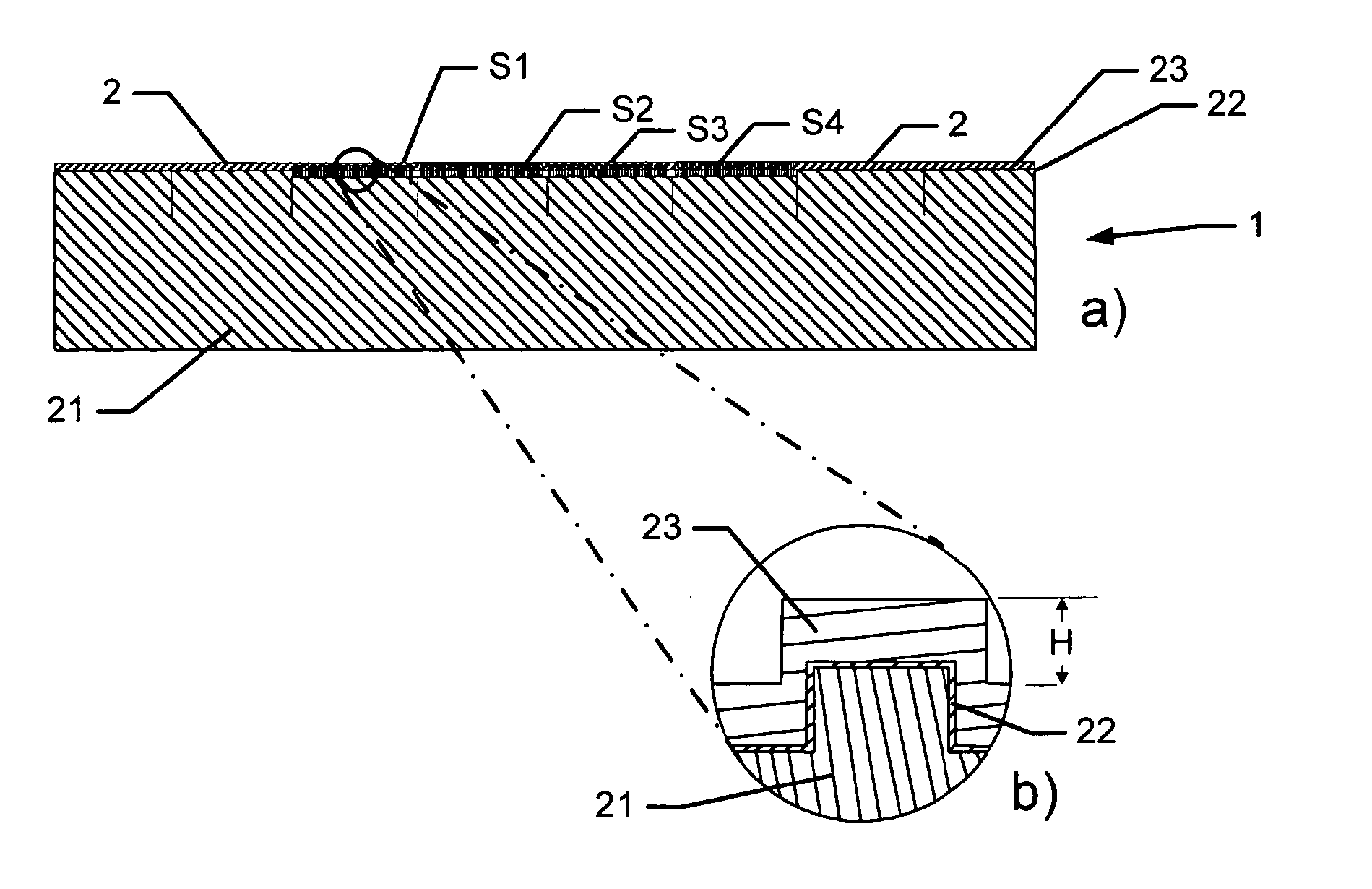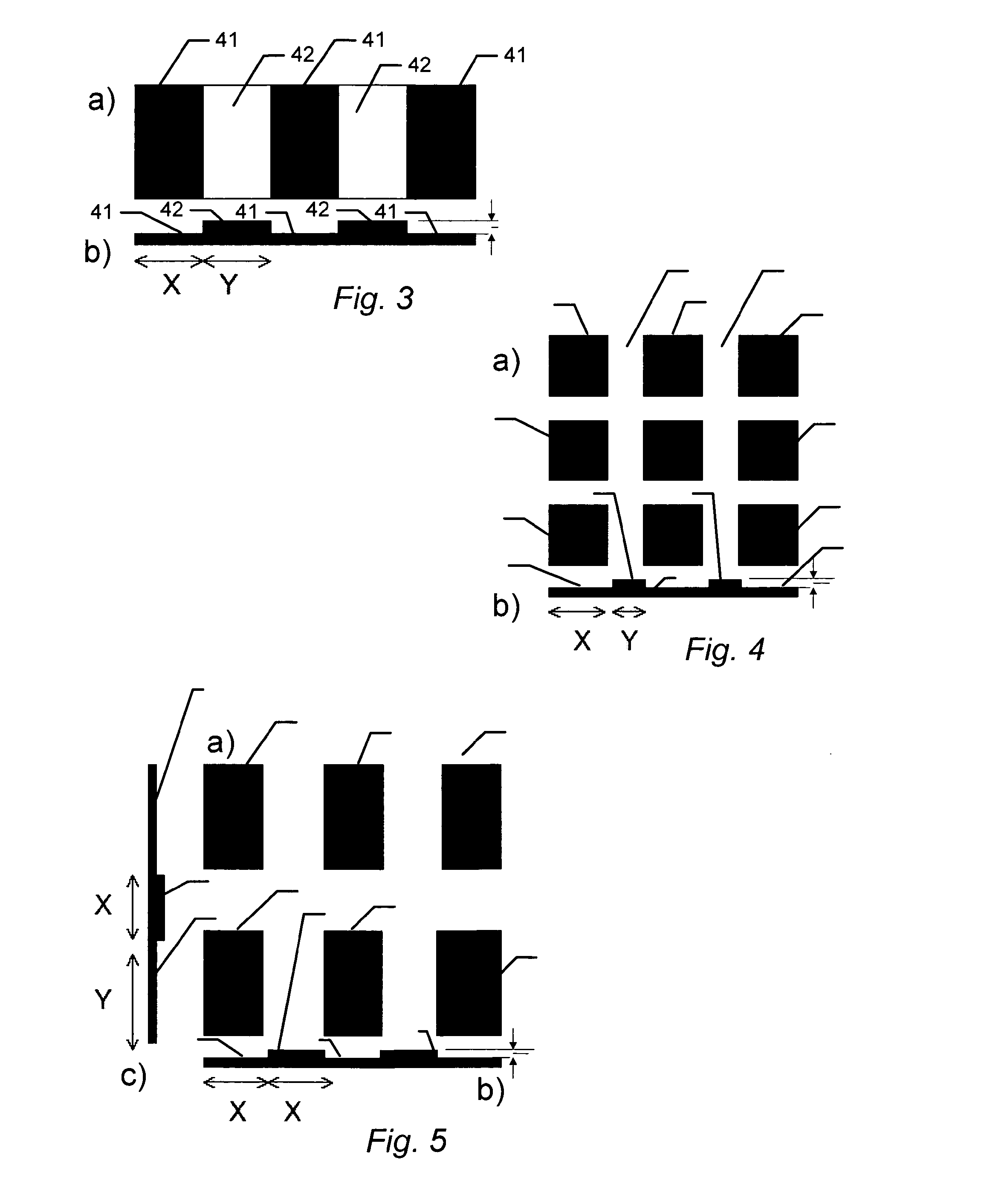Biocompatible materials for mammalian stem cell growth and differentiation
a technology of stem cell growth and biocompatibility, applied in the field of biocompatibility materials, can solve the problems of increasing public health problems, increasing the cost of culture systems, and not always giving rise to es cells suitable for all forms of therapy, and achieve the effect of promoting the above-mentioned cell function
- Summary
- Abstract
- Description
- Claims
- Application Information
AI Technical Summary
Benefits of technology
Problems solved by technology
Method used
Image
Examples
example 1
Manufacture of a BSSA Wafer Comprising 13×3 Tantalum Array of Tester Areas
[0150]A single-sided polished silicon wafer with a thickness of 525±25 μm provided a substratum for the manufacture of a biocompatible material. The wafer was an n-type wafer with a resistivity of 1-20 ohm cm. A micrometer-sized pattern was printed onto the polished side of the silicon wafer by standard photolithography and reactive ion etching in a SF6 / 02 discharge according to the following protocol:[0151]1. The wafers were pre-etched with buffered hydrofluoric acid (BHF, BHF is a solution of concentrated HF (49%), water, and a buffering salt, NH4F, in about the ratio 1:6:4) for 30 seconds and then dried under N2 flow, and[0152]2. the wafer was then spin-coated with a 1.5 μm thick layer of photoresist AZ5214, Hoechst Celanese Corporation, NJ, US (the chemical composition can be found at the Material Safety Data Sheet (MSDS) supplied by Hoechst Celanese Corporation). and pre-baked at around 90° C. for 120 sec...
example 2
Identification of Biocompatible Surfaces for Promoting Growth of Pluripotent Mouse Embryonic Stem (ES) Cells
[0164]Undifferentiated murine ES cells grow in compact, well-defined colonies (FIG. 10). When colonies flatten and spread out, the ES cells most likely have started to differentiate. Thus, colony morphology is an obvious and generally accepted marker of pluripotency. Examples of well established intracellular pluripotency markers are the transcription factors Oct4 and Nanog and the enzyme Alkaline Phosphatase (AP).
[0165]ES cells (KH2 cells and CJ7 cells) were seeded at a density from 1.3-5×106 cells / p10 Petri dish on tantalum BSSA wafers (FIG. 11), produced as in Example 1. The cells cultured for cultured for 3 days under conditions of 5% CO2, 90% air humidity and 37° C. The cells were grown in DMEM supplemented with 15% FCS, 2 mM glutamine, 50 U / ml penicillin, 50 μg / ml streptomycin, non-essential amino acids, 100 μM β-mercaptoethanol and nucleosides, but in the absence of a f...
example 3
Pluripotency and Growth Morphology of Mouse Embryonic Stem (ES) Cells is Maintained During Serial Passaging on Biocompatible Surfaces
[0174]The previous examples demonstrate that biocompatible surfaces having different surface structures can be used to promote a high ES colony number (for example structure: F1.2) or to promote low ES colony number (for example structure: F4.1). The sustained effect of these structures on the growth of ES cells was examined during serial passaging of CJ7 and KH2 ES cells. After each passage, the ES cells were fixed and analysed for Oct4 and Nanog expression using antibodies specific for Oct4 and Nanog. The ES cells CJ7 and KH2 still express the pluripotency markers after 6 and 10 passages respectively on F1.2 (F1.2 has dimensions X=1;Y=2) or F4.1. (F4.1 has dimensions X=4;Y=1). The CJ7 and KH2 cells also expressed alkaline phosphatase in the last passage. ES colonies generated on F1.2 structures retained a compact and well defined morphology during pa...
PUM
| Property | Measurement | Unit |
|---|---|---|
| diameter | aaaaa | aaaaa |
| diameter | aaaaa | aaaaa |
| diameter | aaaaa | aaaaa |
Abstract
Description
Claims
Application Information
 Login to View More
Login to View More - R&D
- Intellectual Property
- Life Sciences
- Materials
- Tech Scout
- Unparalleled Data Quality
- Higher Quality Content
- 60% Fewer Hallucinations
Browse by: Latest US Patents, China's latest patents, Technical Efficacy Thesaurus, Application Domain, Technology Topic, Popular Technical Reports.
© 2025 PatSnap. All rights reserved.Legal|Privacy policy|Modern Slavery Act Transparency Statement|Sitemap|About US| Contact US: help@patsnap.com



